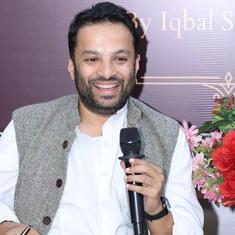Krishna and Radha Enjoying a Feast and Fireworks. Rajasthan, Kishangarh, early 19th century. Photo courtesy: Los Angeles County Museum of Art.
It is a prelude to the din of Diwali. Every year, come the Festival of Lights, there is a debate on whether people should burst firecrackers at all, particularly in urban spaces.
Those who oppose firecrackers, of course, have a point. Cities on the cusp of winter already tend to suffer smog as low temperatures prevent existing pollutants from vehicles and factories from rising. The atom bombs and phuljharis of Diwali exacerbate this by spitting clouds of smoke into the air. The firecracker critics point to tradition: the festival is supposed to welcome Ram with lights, not deafen him and family with loud crackers, as even priests concede.
Firecrackers, however, are older than the detractors remember. In China, where the explosive mixture of saltpetre and sulphur was perfected, fireworks have been recorded as early as around the sixth century.
At home, in India, there is evidence of them from at least the 15th century. And not just in texts. Like anything bordering on the spectacular, fireworks were frequently and casually included in paintings of celebrations.

Court Ladies Playing with Fireworks. Attributed to Muhammad Afzal (active 1740-1780), Mughal court. Photo courtesy: Freer Gallery of Art.
Not just Diwali
In 1953, PK Gode, a historian and the first curator of the Bhandarkar Oriental Research Institute, wrote The History of Fireworks in India Between AD 1400 and 1900, an invaluable tract that sifts through rare written sources of information to trace fireworks through Indian history. Gode, then at the height of his career, discarded poor translations and highlighted several sources in Sanskrit, Marathi and even French.
Fireworks, he found, were widely used to celebrate weddings – noisy baraat processions seem to have a precedent – and festivals. He records Portuguese traveller Duarte Barbosa’s account of fireworks being used to bring in a wedding of a Brahmin couple in Gujarat in 1518, which would point to their wide availability.

The marriage procession of Dara Shikoh, 1740s. Photo courtesy: National Museum, Delhi.
People even used them to train large animals such as elephants, as François Bernier, a French traveller, noted in wonder when travelling to Delhi and Agra in the early 17th century:
“…The animals can be separated only by means of cherkys or fireworks, which are made to explode between them; for they are naturally timid, and have a particular dread of fire, which is the reason why elephants have been used with so little advantage in armies since the use of firearms.”

Jahangir Watching an Elephant Fight, ca 1605. Photo courtesy: Metropolitan Museum of Art.
Nor were they limited to just one part of India. Among the several tracts Gode found was an early list of ingredients for fireworks from the region that falls in present-day Odisha. Dated to early 16th century, the list in Sanskrit includes cow urine as one of its ingredients. Another text, 300 years later, does not mention it.
As the images remind us, fireworks were used not just for Hindu festivals such as Diwali, but also for occasions such as Shab e barat, the Muslim night of vigil and atonement.

"Fireworks on the Night of Shab-i Barat Feast", Folio from the Davis Album. 18th century. Photo courtesy: Metropolitan Museum of Art.
Gode also notes contemporary descriptions of how they must have looked and sounded. He cites a Marathi poem written in 1570 by Sant Eknath describing fireworks at Rukmini and Krishna’s wedding. Fireworks were still being used in 1820, when Sayajirao II of Baroda celebrated his second marriage with Rs 3,000 worth of fireworks.

Maharana Ari Singh Attending Celebrations in His Palace at Night. Bhima Ram, Kesu Ram. 1764. Photo courtesy: Freer Gallery of Art.
At the end of his tract, Gode acknowledges several gaps in his research. We do not know, for instance, who first introduced fireworks to India from China, or when. Nor do we know how the knowledge of fireworks was spread within the country, who the firework makers were, how crackers changed from one century to another, or even whether they were coloured.
These questions he left for those who came after him.

Zenana scene with fireworks. Mughal dynasty, 17th century. Photo courtesy: Freer Gallery of Art.

The grounds of the palace of Farhat Baksh in Lucknow lit by innumerable coloured lamps. Sita Ram, 1814. Photo courtesy: British Library.










